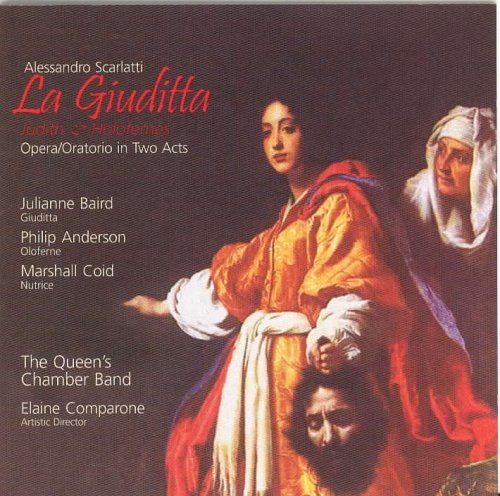
The Queen’s Chamber Band - Scarlatti: La Giuditta (2007)
BAND/ARTIST: The Queen’s Chamber Band
- Title: Scarlatti: La Giuditta
- Year Of Release: 2007
- Label: Albany Records
- Genre: Classical oratorio
- Quality: FLAC (image+.cue,log,scans)
- Total Time: 01:33:08
- Total Size: 407 MB
- WebSite: Album Preview
What’s in a name? Opera, as such, was frowned upon in Rome around the turn of the 18th century, so the urge for sung drama was channeled into oratorio instead (or opera proibita, as Cecilia Bartoli called it on her latest CD).
Call it opera, call it oratorio, call it serenata (a similar, but secular, form of sung drama). It was a popular entertainment in aristocratic circles; Alessandro Scarlatti was a prolific composer of it; and it was revived, or exhumed, on Wednesday in the form of Scarlatti’s “Giuditta” (a k a. Judith and Holofernes), performed at Weill Hall with the Queen’s Chamber Band and its indefatigable harpsichord leader, Elaine Comparone.
“La Giuditta” was conceived as an elite entertainment, and the intimacy of the tiny, sold-out hall evoked the aristocratic milieu for which the work was written. Yet the piece had a kind of stridency, and not only because it is about a woman cutting off a man’s head. Indeed, the beheading was positively subdued, effected with a couple of downward runs of the accompaniment. Rather, the stridency lay more with the first violin, which sounded as if it was very slightly, but consistently, out of tune, despite Ms. Comparone’s lusty efforts to support it.
Scarlatti wrote some lovely arias for his three singers, particularly Giuditta (or, Judith), taken here by the sweet-voiced Julianne Baird. After entering the enemy camp, she sings an aria miming fear and helplessness (“Chi m’addita, per pietà”) in which her dissimulation is signaled by an absence of continuo, leaving an unsupported-sounding accompaniment of violin and viola: an effective dramatic moment. Another highlight was “Non ti curo, o libertà,” which starts as a soprano aria and then adds a codalike duet of the same words, to a quite different melody, for Giuditta and her nurse (the journeyman countertenor Marshall Coid).
One might expect Holofernes, the enemy general, to be a thundering bass; but in Scarlatti’s rendering he is a distinguished and well-behaved tenor. And although his first entrance sounded downright fiery after so much soprano singing, Philip Anderson proved restrained, holding his voice to an even line by suppressing the bottom part of it. It’s a nice sound, but comes off as weak: if he opened it up, he might be surprised at his strength, rather than being, like his character, subjugated by a strong woman.
Call it opera, call it oratorio, call it serenata (a similar, but secular, form of sung drama). It was a popular entertainment in aristocratic circles; Alessandro Scarlatti was a prolific composer of it; and it was revived, or exhumed, on Wednesday in the form of Scarlatti’s “Giuditta” (a k a. Judith and Holofernes), performed at Weill Hall with the Queen’s Chamber Band and its indefatigable harpsichord leader, Elaine Comparone.
“La Giuditta” was conceived as an elite entertainment, and the intimacy of the tiny, sold-out hall evoked the aristocratic milieu for which the work was written. Yet the piece had a kind of stridency, and not only because it is about a woman cutting off a man’s head. Indeed, the beheading was positively subdued, effected with a couple of downward runs of the accompaniment. Rather, the stridency lay more with the first violin, which sounded as if it was very slightly, but consistently, out of tune, despite Ms. Comparone’s lusty efforts to support it.
Scarlatti wrote some lovely arias for his three singers, particularly Giuditta (or, Judith), taken here by the sweet-voiced Julianne Baird. After entering the enemy camp, she sings an aria miming fear and helplessness (“Chi m’addita, per pietà”) in which her dissimulation is signaled by an absence of continuo, leaving an unsupported-sounding accompaniment of violin and viola: an effective dramatic moment. Another highlight was “Non ti curo, o libertà,” which starts as a soprano aria and then adds a codalike duet of the same words, to a quite different melody, for Giuditta and her nurse (the journeyman countertenor Marshall Coid).
One might expect Holofernes, the enemy general, to be a thundering bass; but in Scarlatti’s rendering he is a distinguished and well-behaved tenor. And although his first entrance sounded downright fiery after so much soprano singing, Philip Anderson proved restrained, holding his voice to an even line by suppressing the bottom part of it. It’s a nice sound, but comes off as weak: if he opened it up, he might be surprised at his strength, rather than being, like his character, subjugated by a strong woman.
Tracklist:
CD1
01-18. LA GIUDITTA, Oratorio in Two Acts (c. 1700): Part I
19-23. Sonata No. 3 in D Minor
CD2
01-23. LA GIUDITTA, Oratorio in Two Acts (c. 1700): Part II
As a ISRA.CLOUD's PREMIUM member you will have the following benefits:
- Unlimited high speed downloads
- Download directly without waiting time
- Unlimited parallel downloads
- Support for download accelerators
- No advertising
- Resume broken downloads


